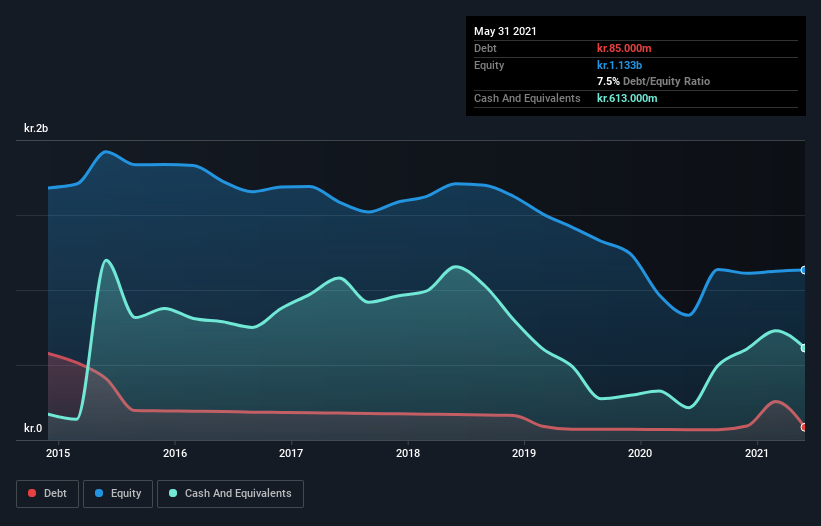David Iben put it well when he said, 'Volatility is not a risk we care about. What we care about is avoiding the permanent loss of capital.' So it might be obvious that you need to consider debt, when you think about how risky any given stock is, because too much debt can sink a company. As with many other companies Bang & Olufsen a/s (CPH:BO) makes use of debt. But the more important question is: how much risk is that debt creating?
Why Does Debt Bring Risk?
Generally speaking, debt only becomes a real problem when a company can't easily pay it off, either by raising capital or with its own cash flow. Ultimately, if the company can't fulfill its legal obligations to repay debt, shareholders could walk away with nothing. However, a more common (but still painful) scenario is that it has to raise new equity capital at a low price, thus permanently diluting shareholders. Of course, the upside of debt is that it often represents cheap capital, especially when it replaces dilution in a company with the ability to reinvest at high rates of return. The first thing to do when considering how much debt a business uses is to look at its cash and debt together.
See our latest analysis for Bang & Olufsen
How Much Debt Does Bang & Olufsen Carry?
As you can see below, at the end of May 2021, Bang & Olufsen had kr.85.0m of debt, up from kr.69.0m a year ago. Click the image for more detail. However, it does have kr.613.0m in cash offsetting this, leading to net cash of kr.528.0m.

How Healthy Is Bang & Olufsen's Balance Sheet?
We can see from the most recent balance sheet that Bang & Olufsen had liabilities of kr.889.0m falling due within a year, and liabilities of kr.254.0m due beyond that. On the other hand, it had cash of kr.613.0m and kr.561.0m worth of receivables due within a year. So it can boast kr.31.0m more liquid assets than total liabilities.
Having regard to Bang & Olufsen's size, it seems that its liquid assets are well balanced with its total liabilities. So while it's hard to imagine that the kr.3.79b company is struggling for cash, we still think it's worth monitoring its balance sheet. Succinctly put, Bang & Olufsen boasts net cash, so it's fair to say it does not have a heavy debt load!
Notably, Bang & Olufsen made a loss at the EBIT level, last year, but improved that to positive EBIT of kr.40m in the last twelve months. When analysing debt levels, the balance sheet is the obvious place to start. But it is future earnings, more than anything, that will determine Bang & Olufsen's ability to maintain a healthy balance sheet going forward. So if you're focused on the future you can check out this free report showing analyst profit forecasts.
Finally, a business needs free cash flow to pay off debt; accounting profits just don't cut it. Bang & Olufsen may have net cash on the balance sheet, but it is still interesting to look at how well the business converts its earnings before interest and tax (EBIT) to free cash flow, because that will influence both its need for, and its capacity to manage debt. Over the last year, Bang & Olufsen actually produced more free cash flow than EBIT. There's nothing better than incoming cash when it comes to staying in your lenders' good graces.
Summing up
While we empathize with investors who find debt concerning, you should keep in mind that Bang & Olufsen has net cash of kr.528.0m, as well as more liquid assets than liabilities. The cherry on top was that in converted 283% of that EBIT to free cash flow, bringing in kr.113m. So we don't have any problem with Bang & Olufsen's use of debt. While Bang & Olufsen didn't make a statutory profit in the last year, its positive EBIT suggests that profitability might not be far away. Click here to see if its earnings are heading in the right direction, over the medium term.
When all is said and done, sometimes its easier to focus on companies that don't even need debt. Readers can access a list of growth stocks with zero net debt 100% free, right now.
If you're looking for stocks to buy, use the lowest-cost* platform that is rated #1 Overall by Barron’s, Interactive Brokers. Trade stocks, options, futures, forex, bonds and funds on 135 markets, all from a single integrated account. Promoted
Valuation is complex, but we're here to simplify it.
Discover if Bang & Olufsen might be undervalued or overvalued with our detailed analysis, featuring fair value estimates, potential risks, dividends, insider trades, and its financial condition.
Access Free AnalysisThis article by Simply Wall St is general in nature. We provide commentary based on historical data and analyst forecasts only using an unbiased methodology and our articles are not intended to be financial advice. It does not constitute a recommendation to buy or sell any stock, and does not take account of your objectives, or your financial situation. We aim to bring you long-term focused analysis driven by fundamental data. Note that our analysis may not factor in the latest price-sensitive company announcements or qualitative material. Simply Wall St has no position in any stocks mentioned.
*Interactive Brokers Rated Lowest Cost Broker by StockBrokers.com Annual Online Review 2020
Have feedback on this article? Concerned about the content? Get in touch with us directly. Alternatively, email editorial-team (at) simplywallst.com.
About CPSE:BO
Bang & Olufsen
Designs, develops, markets, manufactures, and sells audio and video products in Europe, the Middle East, Africa, the Americas, and the Asia Pacific.
Excellent balance sheet and good value.
Similar Companies
Market Insights
Community Narratives



